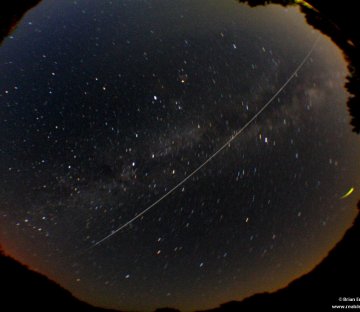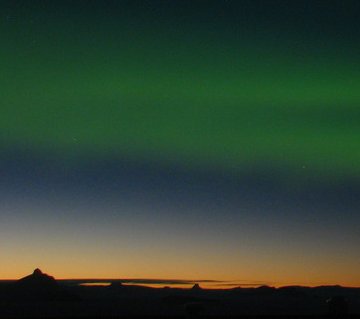 Where's Saturn? Is that a UFO--or the ISS? What's the name of that star? Get the answers from mySKY--a fun new astronomy helper from Meade. . Where's Saturn? Is that a UFO--or the ISS? What's the name of that star? Get the answers from mySKY--a fun new astronomy helper from Meade. . PROMINENCE ALERT: "Today's atmospheric seeing was mediocre, but I couldn't resist sketching some of the large faint prominences on the sun's northwestern limb," says Les Cowley of England. Here is the view through his Coronado SolarMax60 at 50x magnification. If you have a solar telescope of your own, take a look! more images: from John Nassr of Baguio, the Philippines. SIGHTINGS: This week, the International Space Station is flying over the United States and putting on a good show for evening sky watchers. "The space station came over my house last night and it sure was bright," says Brian Emfinger of Ozark, Arkansas. He recorded the passage using his Canon Digital Rebel XT: 
Photo details: Canon Digital Rebel XT, fisheye lens, ISO 1600, 310 sec
The space station has been getting brighter lately for one simple reason: its getting bigger. During recent shuttle missions, astronauts have unfurled a new set of 256-ft solar panels and installed more than 35,000 pounds of truss.The next shuttle mission, due to launch on Oct. 23rd, will add a 31,000-pound Italian module named Harmony to the sprawling complex. Each addition increases the station's sun-reflecting surface area. Just how bright is it? This is a good week to see for yourself. Check Heavens Above for flyby timetables or sign up for Spaceweather PHONE and we'll call you when the ISS is about to fly over your hometown. NOTE: The bright object, center-right, in Brian's photo is not a comet but a lightning bug. "That was the only one I saw and it came right over to the camera," he says. AURORA SUNRISE: Last night in Antarctica, "the fight between day and night couldn't suppress the auroras," says Chantal Steyn who sends this picture from Dronning Maudland (Queen Maud Land): 
Photo details: Canon IS3, ISO 100, 15 sec
Steyn is a member of the South African National Antarctic Expedition, currently "wintering over" at a nunatak named Vesleskarvet. But winter is turning to summer: "This might be our last aurora sighting for the season as daylight starts to take over," she says. "This picture was taken at 1:45 AM and the glow of daylight is already visible on the horizon." At its peak, the disturbance that produced these lights registered 4 on the 0-to-9 K-index scale of geomagnetic storms. The mini-storm is subsiding now and the chances for more auroras tonight are low. September 2007 Aurora Gallery
[August 2007 Aurora Gallery] [Aurora Alerts] | 
